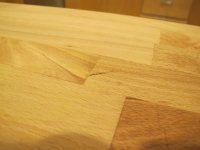Len Kuffert
Member
- Joined
- Nov 3, 2013
- Messages
- 16
Hi folks,
This is my first post on the FOG, having just bought a TS55 and MFT/3 about a month ago. I'm amazed by both, and already thinking of projects to justify getting the next couple of items on the wish list (OF 1400 and CT 26, if Santa's lurking).
One of the things I've done so far is installing a beech butcher block countertop. It came from Ikea, and the TS55 ripped it to the right width without a problem, super smooth. However, there's a gouge that has showed up as we've been using the surface, and I'd like any advice on how to tackle it. Should I pare it away with a chisel, and then sand? It's on the end of one of the finger-jointed pieces. Any ideas would be welcome.
I've attached a picture.
thanks in advance,
Len
This is my first post on the FOG, having just bought a TS55 and MFT/3 about a month ago. I'm amazed by both, and already thinking of projects to justify getting the next couple of items on the wish list (OF 1400 and CT 26, if Santa's lurking).
One of the things I've done so far is installing a beech butcher block countertop. It came from Ikea, and the TS55 ripped it to the right width without a problem, super smooth. However, there's a gouge that has showed up as we've been using the surface, and I'd like any advice on how to tackle it. Should I pare it away with a chisel, and then sand? It's on the end of one of the finger-jointed pieces. Any ideas would be welcome.
I've attached a picture.
thanks in advance,
Len

